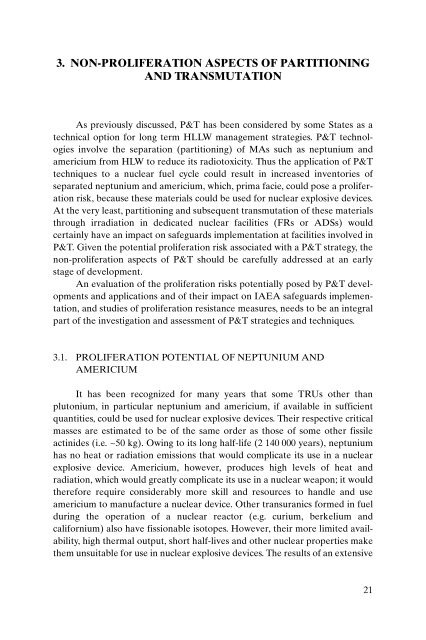TRS435_web
TRS435_web
TRS435_web
Create successful ePaper yourself
Turn your PDF publications into a flip-book with our unique Google optimized e-Paper software.
3. NON-PROLIFERATION ASPECTS OF PARTITIONING<br />
AND TRANSMUTATION<br />
As previously discussed, P&T has been considered by some States as a<br />
technical option for long term HLLW management strategies. P&T technologies<br />
involve the separation (partitioning) of MAs such as neptunium and<br />
americium from HLW to reduce its radiotoxicity. Thus the application of P&T<br />
techniques to a nuclear fuel cycle could result in increased inventories of<br />
separated neptunium and americium, which, prima facie, could pose a proliferation<br />
risk, because these materials could be used for nuclear explosive devices.<br />
At the very least, partitioning and subsequent transmutation of these materials<br />
through irradiation in dedicated nuclear facilities (FRs or ADSs) would<br />
certainly have an impact on safeguards implementation at facilities involved in<br />
P&T. Given the potential proliferation risk associated with a P&T strategy, the<br />
non-proliferation aspects of P&T should be carefully addressed at an early<br />
stage of development.<br />
An evaluation of the proliferation risks potentially posed by P&T developments<br />
and applications and of their impact on IAEA safeguards implementation,<br />
and studies of proliferation resistance measures, needs to be an integral<br />
part of the investigation and assessment of P&T strategies and techniques.<br />
3.1. PROLIFERATION POTENTIAL OF NEPTUNIUM AND<br />
AMERICIUM<br />
It has been recognized for many years that some TRUs other than<br />
plutonium, in particular neptunium and americium, if available in sufficient<br />
quantities, could be used for nuclear explosive devices. Their respective critical<br />
masses are estimated to be of the same order as those of some other fissile<br />
actinides (i.e. ~50 kg). Owing to its long half-life (2 140 000 years), neptunium<br />
has no heat or radiation emissions that would complicate its use in a nuclear<br />
explosive device. Americium, however, produces high levels of heat and<br />
radiation, which would greatly complicate its use in a nuclear weapon; it would<br />
therefore require considerably more skill and resources to handle and use<br />
americium to manufacture a nuclear device. Other transuranics formed in fuel<br />
during the operation of a nuclear reactor (e.g. curium, berkelium and<br />
californium) also have fissionable isotopes. However, their more limited availability,<br />
high thermal output, short half-lives and other nuclear properties make<br />
them unsuitable for use in nuclear explosive devices. The results of an extensive<br />
21


